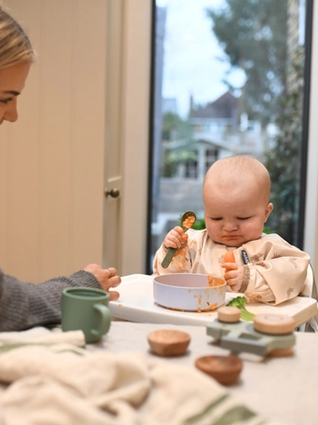
- Home
- Advice Hub
- Baby
- Weaning
- Gagging Vs. Choking: What’s The Difference?
The difference between gagging and choking when weaning
Learn the key differences between gagging and choking during weaning. This guide helps parents understand these reflexes to ensure safer feeding experiences.
Introducing solid foods is an exciting milestone (of course we think that!), but the fear of choking is a very common and very real one. While gagging is a natural part of a baby’s learning process as they handle new textures, choking can be life-threatening and requires action from parents. In this guide, we’ll explain how to spot the differences and provide you with essential information on what to do if your baby is choking.
What is Gagging?
Gagging is a reflex that helps to protect your baby from choking when they start to eat solid food, and although it can be alarming at first, it isn’t dangerous. It allows your baby to bring food from the back of their mouth forward, so they can either spit it out or chew it more before swallowing. Gagging is more likely to happen as they adapt to the different textures and food sizes given during weaning.
At the start of weaning your baby’s gag reflex is located much further forward on the tongue than yours, which means it is triggered much more easily. It starts to move backwards towards the back of the mouth between 6 and 9 months, but all babies are different so try not to be alarmed if your baby seems to gag more often than other babies.
Common signs of baby gagging include:
- Coughing and spluttering
- Tongue thrusting out
- Grunting
- Watery eyes
- Red face
What to do if baby is gagging when eating?
It is easier said than done, but if your baby starts gagging during a mealtime, try to remain calm. Panicking may scare your baby and make them upset. Here’s what you should do:
- Give them time: most babies will gag and quickly resolve the situation on their own by coughing or spitting out the food. They may even pick the same piece back up again and start again!
- Avoid patting them on the back: patting your baby on the back while they are gagging may push the food further down their throat, which can cause them to choke. Let them work through the issue naturally.
What is choking?
Choking happens when food or an object completely or partially blocks the airway, stopping normal breathing. Unlike gagging, choking is a medical emergency and requires immediate action.
Signs of choking include:
- Unable to breathe
- Silent or weak coughing (as opposed to loud gagging noises)
- Blue or pale lips
- Panicked, wide-eyed expression
- Inability to make any noise
- Clutching at the throat
- Loss of consciousness (if not resolved quickly)
How to tell the difference between gagging and choking?
In the moment it can feel very stressful if your baby is having difficulty; so here are the main things to think about when it comes to gagging vs choking:
- Noise: A gagging baby is usually noisy; coughing, spluttering, or making retching sounds. A choking baby, on the other hand, will be silent or unable to make any sound if their airway is blocked.
- Breathing: A baby who is gagging will still be able to breathe, though it may be uncomfortable for them. A baby who is choking will struggle or be unable to breathe.
- Facial Colour: A choking baby may start to go pale or blue if they have white skin; if they have brown or black skin you may see the gums or nail beds start to turn pale.Babies who are gagging may have a red or flushed face due to the effort of coughing or gagging; this will be easy to see on white skin but more difficult on brown or black skin.
- Body Language: Babies gagging will continue to move and might try to spit the food out, while a choking baby will show signs of panic, such as grabbing their throat or appearing frozen in fear.
What to do if your baby is choking?
Please note that this article should not be considered a replacement for medical guidance or certified first aid training. We strongly encourage you to participate in a first aid course before you start weaning. If you’ve already begun the process and haven’t taken a course yet, there’s still time to equip yourself with all the right knowledge in the unlikely event that your baby chokes.
If you suspect your baby is choking, you need to act immediately. Follow these steps:
- Firstly, never put your fingers into your baby’s mouth as you may accidentally push food further down.
- If your baby is silent or unable to breathe:
- Place your baby face-down across your lap, with their head slightly lower than their legs whilst supporting their head and neck.
- Give up to 5 firm back blows between the shoulder blades using the heel of your hand.
- If this doesn’t work, turn the baby onto their back, and give up to 5 chest thrusts using two fingers placed just below the nipple line.
- Call emergency services if the object is not dislodged after back blows and chest thrusts, or if the baby becomes unresponsive. Continue alternating between back blows and chest thrusts until help arrives or the object is expelled.
How to prevent choking?
While it’s impossible to completely eliminate the risk of choking, you can minimise it by taking certain precautions during meals:
- Wait until your baby is developmentally ready for weaning before you start.
- Cut food into appropriate sizes: For babies and toddlers, cut food into small, bite-sized pieces. Round foods, such as grapes or cherry tomatoes, should be halved or quartered.
- Avoid certain foods: Some foods pose a higher risk of choking, including:
- Whole grapes
- Whole nuts and seeds
- Popcorn
- Hard sweets or marshmallows
- Large chunks of hard uncooked fruits and vegetables
- Large chewy chunks of meat or cheese
- Sausages and hot dogs (unless quartered lengthwise)
- Nut butters on their own. Always spread thinly, and water down with warm water if very thick in the jar.
- Always sit with your baby whilst they are eating and ensure they are seated in an upright position in a proper high chair or booster.
Understanding the difference between gagging and choking is vital for your baby’s safety during weaning. Research shows that when offered safely there’s no more risk of choking with finger foods as there is with spoon feeding; the important thing is going at your baby’s pace and ensuring appropriate foods are offered. Try to remember that eating is a skill like everything else and your baby needs to be exposed to new textures in order to learn how to eat them.
Finally – don’t forget to do a baby first aid course if you haven’t already; and if your baby does choke and you cannot dislodge the food call an ambulance immediately.












